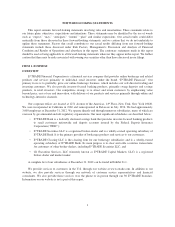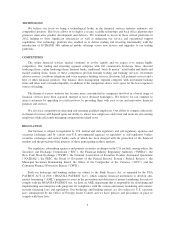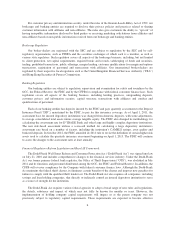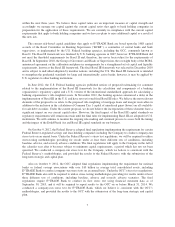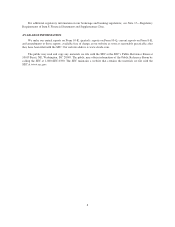eTrade 2012 Annual Report Download - page 14
Download and view the complete annual report
Please find page 14 of the 2012 eTrade annual report below. You can navigate through the pages in the report by either clicking on the pages listed below, or by using the keyword search tool below to find specific information within the annual report.have provided incomplete or untimely information to us about our loan portfolio. For example, provision for loan
losses increased in the third quarter of 2012 in connection with our discovery that one of our third party loan
servicers had not been reporting historical bankruptcy data to us on a timely basis and as a result, we recorded
additional charge-offs in the third quarter of 2012. In connection with this discovery, we implemented an
enhanced procedure around all servicer reporting to corroborate bankruptcy reporting with independent third
party data.
We could experience significant losses on other securities held on the balance sheet.
At December 31, 2012, we held $260.1 million in amortized cost of non-agency collateralized mortgage
obligations (“CMO”) on our consolidated balance sheet. We incurred net impairment charges of $16.9 million
during 2012, which was a result of the deterioration in the expected credit performance of the underlying loans in
the securities. If the credit quality of these securities further deteriorates, we may incur additional impairment
charges which would have an adverse effect on our regulatory capital position and our results of operations in
future periods.
Loss of customers and assets could destabilize the Company or result in lower revenues in future periods.
During November 2007, well-publicized concerns about E*TRADE Bank’s holdings of asset-backed
securities led to widespread concerns about our continued viability. From the beginning of this crisis through
December 31, 2007, when the situation stabilized, customers withdrew approximately $5.6 billion of net cash and
approximately $12.2 billion of net assets from our bank and brokerage businesses. Many of the accounts that
were closed belonged to sophisticated and active customers with large cash and securities balances. While we
were able to stabilize our retail franchise, concerns about our viability may recur, which could lead to
destabilization and asset and customer attrition. If such destabilization should occur, there can be no assurance
that we will be able to successfully rebuild our franchise by reclaiming customers and growing assets. If we are
unable to sustain or, if necessary, rebuild our franchise, in future periods our revenues could be lower and our
losses could be greater than we have experienced.
We have a large amount of corporate debt.
We have issued a substantial amount of corporate debt, with restrictive financial and other covenants and
our expected annual interest cash outlay is approximately $110 million. Our ratio of corporate debt to equity
(expressed as a percentage) was 36% at December 31, 2012. The degree to which we are leveraged could have
important consequences, including: 1) a substantial portion of our cash flow from operations is dedicated to the
payment of principal and interest on our indebtedness, thereby reducing the funds available for other purposes; 2)
our ability to obtain additional financing for working capital, capital expenditures, acquisitions and other
corporate needs is significantly limited; and 3) our substantial leverage may place us at a competitive
disadvantage, hinder our ability to adjust rapidly to changing market conditions and make us more vulnerable in
the event of a further downturn in general economic conditions or our business. In addition, a significant
reduction in revenues could have a material adverse effect on our ability to meet our debt obligations.
We conduct all of our operations through subsidiaries and have no revenue sources other than dividends from
our subsidiaries, which are subject to advance regulatory approval in the case of our most significant
subsidiaries.
We depend on dividends, distributions and other payments from our subsidiaries to fund payments on our
obligations, including our debt obligations. Regulatory and other legal restrictions limit our ability to transfer
funds to or from our subsidiaries. In addition, many of our subsidiaries are subject to laws and regulations that
authorize regulatory bodies to block or reduce the flow of funds to us, or that prohibit such transfers altogether in
certain circumstances. These laws and regulations may hinder our ability to access funds that we may need to
make payments on our obligations, including our debt obligations. The majority of our capital is invested in our
11


